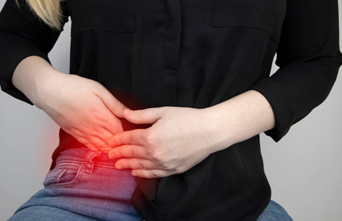Dalmia Clinic...
Dalmia Clinic...

Hemorrhoids are enlarged veins located in the lower part of the rectum and the anus. They become swollen because of increased pressure within them, usually due to straining at stools.
Internal hemorrhoids are located in the inside lining of the rectum and cannot be felt. They are usually painless and may bleed or protrude through the anus.
External hemorrhoids are located underneath the skin that surrounds the anus. They can be felt when they swell and may cause itching or pain with a bowel movement, as well as bleeding.
A thrombosed external hemorrhoid occurs when blood within the vein clots, and can cause significant pain.
What treatments are available?
It is important to remember that uncomfortable hemorrhoid symptoms are not life threatening when diagnosed properly. Most hemorrhoid symptoms, such as hemorrhoids that feel itchy or mildly uncomfortable, can be treated with medications or OPD procedures. Do not be afraid of having your hemorrhoids treated, as the OPD procedures are quite painless and can prevent the need for a surgery.
Please keep in mind that not all symptoms that feel like lumps and bleeding in the rectal area are caused by hemorrhoids. Other diseases can produce symptoms which feel like hemorrhoids. Therefore, if you have any hemorrhoid symptoms which feel like an anal lump, bleeding, discharge, pain, prolapse, or itching, it is important to seek the help of a surgeon.
 Self-Care at Home
Self-Care at Home
A variety of surgical options exist for persistent pain or bleeding.
Rubber band ligation: Rubber band ligation of internal hemorrhoids can be done in the OPD. The surgeon places a couple of tight rubber bands around the base of the hemorrhoidal vein causing it to lose its blood supply. There may be some fullness or discomfort for 1-2 days after the procedure and a minor amount of bleeding may be experienced.
Sclerotherapy: Sclerotherapy is a procedure when a chemical is injected into the hemorrhoid causing it to scar.
Hemorrhoidectomy: Gold Standard treatment for Haemorrhoid. Hemorrhoidectomy is a surgical procedure done in the operating room with an anesthetic agent (general or spinal) where the whole hemorrhoid is removed . This is the most aggressive approach and there is a markedly decreased chance of the hemorrhoids returning.
Stapled hemorrhoidectomy: Stapled hemorrhoidectomy is the new surgical technique for treating hemorrhoids. A single use stapling device is used to cut off the haemorrhoids. Advantages are that it is minimally invasive, less painful and patient can go back to work early. However, patient may feel stool urgency, heaviness, bleeding, infection and recurrence after this procedure.
Prevention
The risk of hemorrhoids can be decreased by eating a high fiber diet, staying well hydrated, getting regular exercise, and trying to have a bowel movement as soon as possible after the urge arises.
Most people with hemorrhoids have an excellent outcome
FISSURE

Description
Causes:
Risk factors:
Preventive measures
Treatment of Superficial fissures:
It has long been recognized that superficial fissures can be cured conservatively.
Application of local anesthetic cream or gel may help avoid the torture experienced in passage of stools in the patients with acute fissures. Ointments containing xylocain to relieve pain, diltiazem or nitroglycerine to alleviate sphincter spasm and silver nitrate to promote healing .
ANAL FISTULA

An anal fistula is a small channel that develops between the end of the bowel and the skin near the anus.
An anal fistula can cause bleeding and discharge when passing stools - and can be painful.
An anal fistula can occur after surgery to drain an anal abscess.
In some cases, an anal fistula causes persistent drainage. In other cases, where the outside of the channel opening closes, the result may be recurrent anal abscesses.
The only cure for an anal fistula is surgery.
Symptoms of anal fistulas
1) Pain, which is usually constant, throbbing and worse when sitting down
2) Skin irritation around the anus, including swelling, redness and tenderness
3) Discharge of pus or blood
4) Constipation or pain associated with bowel movements
5) Fever
Diagnosis of anal fistulas
Usually, a clinical evaluation - including a digital rectal examination - is sufficient to diagnose an anal fistula, but some patients may require additional tests such as ultrasound, a CT scan or an MRI.
Treatment of anal fistulas
The type of surgery will depend on the position of anal fistula. The options include:
1) Fistulotomy. This is done in 85-95% of cases and involves cutting open the whole length of the fistula in order to flush out the contents. This heals in one to two months.
2) Seton techniques. A seton is a piece of thread which is left in the fistula tract. This may be considered if you are at high risk of developing incontinence when the fistula crosses the sphincter muscles. Sometimes several operations are necessary.
3) Advancement flap procedures. This option is usually when the fistula is considered complex, or there is a high risk of incontinence. The advancement flap is a piece of tissue that is removed from the rectum or from the skin around the anus. During surgery, the fistula tract is removed and the flap is reattached where the opening of the fistula was. The operation is effective in about 70% of cases.
4) Fibrin glue. This is currently the only non-surgical treatment option. The glue is injected into the fistula to seal the tract, then the opening is stitched closed. It is a simple, safe and painless procedure, but long term results for this method are poor. Initial success rates as high as 77% drop to 14% after 16 months.
5) Bioprosthetic plug. This is a cone shaped plug made from human tissue, which is used to block the internal opening of the fistula. Stitches keep it in place. However, this does not completely seal the fistula, so that it can continue to drain. New tissue usually grows around the plug to heal the fistula.The method is currently only used in clinical trials.
